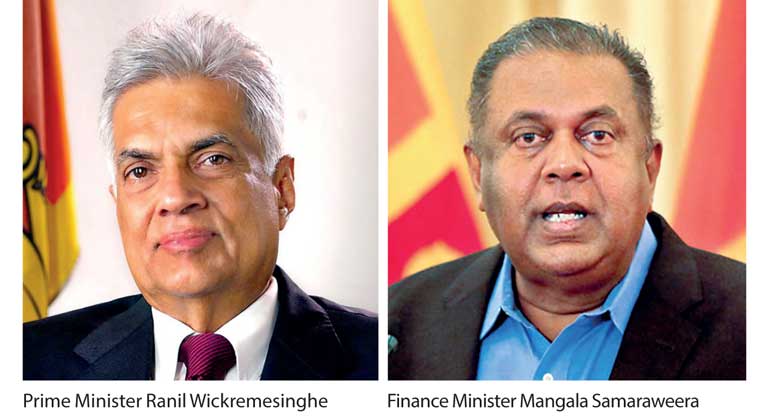Monday Nov 24, 2025
Monday Nov 24, 2025
Tuesday, 14 November 2017 00:00 - - {{hitsCtrl.values.hits}}
 “…restore property rights in accordance with market principles...”
“…restore property rights in accordance with market principles...”
—Finance Minister Mangala Samaraweera, Budget speech
Earlier this year, the country’s top economists and policy planners, current and previous, were gathered together to honour the country’s top development thinker and perhaps the finest Sri Lankan intellect alive, Dr. Godfrey Gunatilleke. The specific occasion was to launch a volume of his writings covering 40 years. Described as ‘A Collection of Writings 1975-2015’ it is with excellent reason that the main title of the volume was ‘Towards a Sri Lankan Model of Development’.
It is this very idea of a ‘Sri Lankan model of development’ and its core concepts, that Mangala Samaraweera’s Budget and the UNP’s economic ideology has made a rupture from, in favour of the embrace of market fundamentalism and ungrounded neoliberal dogma.
The idea of a Sri Lankan model of development was both cause and consequence of decades-long bipartisan, actually multi-party national and social consensus, which brought successful outcomes. Godfrey Gunatilleke sums up the key ideas of this creative national developmentalist consensus, this “somewhat unique development mix it has achieved” (p10) and towards which he was a crucial contributor. There are two key postulates:
1.“…the final outcome—development.” (p17)
2.“…We can take some satisfaction at having arrived where we are—a middle income country enjoying a state of high human development with an economy which is among the fastest growing economies in the world, a multiparty democracy which has been sustained without interruption from the time of independence and a clear prospect of advancing into the state of very high human development during the next two decades.” (‘From
Mangala Samaraweera has ruptured with this national consensus, has gone against the national grain and the Great Tradition of Sri Lankan developmentalism. Not only is his stated outcome “rapid growth”, not “development”; not only does he turn his back on any notion of a successful and desirable Sri Lankan model of development based on its fairly unique experimentation with a creative policy mix; his entire reading of Sri Lanka’s development experience is one of negativism.
“Sri Lanka needs to liberalise and globalise,” pronounces Mangala Samaraweera in his Budget speech, adding that, “…The country needs to shift away from being more protectionist and inward-oriented…We have tried many strategies including protecting local industries through tariffs.” He sounds like Rip Van Winkle. One wonders whether he thinks we are living in 1977 having experienced a closed economy for decades. Sri Lanka certainly needed to liberalise and globalise, and that is what we did under J.R. Jayewardene’s leadership, Ronnie de Mel’s strategising and management, supported by Lalith Athulathmudali and Gamini Dissanaike’s dynamism and Premadasa’s synthesis of ‘growth with equity’.
There is no problem with liberalising and globalising except that we have already done that in several waves. The problem is that there is no evidence that moving forward on that same track will help. This is not to argue for reversal of liberalisation and globalisation. It is however, to argue against going recklessly further, and I say recklessly because Mangala Samaraweera calls for “fast-tracking liberalisation”.
Samaraweera promises to “…restore property rights in accordance with market principles aiming at promoting faster and sustainable growth.” What does he mean by “restore property rights”? To ‘restore’ means to go back to what it was. So when does Samaraweera want the country to go back to? To the era in agriculture prior to the Paddy lands act, in which sharecropping (‘ande’ cultivation) was unchecked and unrewarded? To the era before rent controls made urban housing affordable for the middle classes? To the era before the Land Reforms of 1972 and 1975 which imposed land ceilings of 50 acres?
The UNP of Ranil Wickremesinghe obviously does not know that when the Land Reform Bill was introduced in 1972, R. Premadasa, who was familiar with the formula for social stability and de-radicalisation through creating a rich/middle peasantry (a kulak class) of the brilliant Fr. Peter Pillai: “five acres and a cow”. He moved an amendment from the Opposition benches calling for the land ceiling to be limited to five acres! This was no theatrical gesture. When elected the country’s leader, Premadasa appointed a Presidential Task Force on Land Redistribution which earmarked 750,000 hectares of state land to be given to the landless—NOT corporate business.
When Liberal leader Dr. Chanaka Amaratunga proposed at the All-Parties Conference of 1990 that the Constitution be amended so that private property and that private ownership of land be made a fundamental right, President Premadasa rejected it from the Chair, declaring emphatically that “land is the patrimony of the whole people!” When the plantation sector needed a new dynamism to pull it out of a rut, the same UNP President refused to re-privatise the ownership of the plantations and decided instead to limit the reform to the grant of management contracts for five years to private companies.
The Mangala Budget not only launches an all-out attack on the broadly bipartisan developmental paradigm that Sri Lanka has adhered to, with whatever strategic variations, since Independence, itself the most credible claim to an internationally recognised ‘Sri Lankan exceptionalism’ in a positive sense of the term. By so doing it also attacks the Sri Lankan Social Contract that underlay this developmental paradigm and reciprocally was held together by it.
When one factors in the new Constitution project which does the same thing, undermining the bipartisan paradigm of a unitary state and thereby undermining the National Contract between the Sinhala majority and the state, what we have is a cosmopolitan-liberal or neoliberal-globalist assault on both the Social and National Contracts that kept Sri Lanka intact.
What are the social classes and strata targeted for disintegration or subordination by the Mangala-Ranil Budget? What are the social classes and strata targeted for all-out attack by the Budget?
They are (I) the local industrialists (II) the middle and upper middle classes, including professionals (III) labour and (IV) the peasantry.
How will “our policy of liberalising and globalising” as Mangala puts it, help local industry? Will it not harm it instead? Who will benefit from this policy of fast-tracking further liberalisation and globalisation?
“We have legislations that do not allow foreign investments in certain sectors. Perhaps, most of all, our complex labour laws and bureaucracy have unwittingly obstructed foreign enterprises from entering into the country, thereby, preventing the much needed competition for the local industries.”
What will befall local industry when foreign industries enter the local market unimpeded? And what happens when having decimated our local manufacturing base, they move away as foreign industries have done in many countries, as well as areas within countries, some of them in the developed West, leaving such zones and populations prostrate?
“…For example; the Rent Act, No. 7 of 1972 which limits the ownership of houses and the rent to be charged  requires amendments...”
requires amendments...”
“As I already mentioned, we will remove restrictions that limit the land ownership rights of listed companies with foreign ownership together with the restrictions on foreigners’ ability to purchase condominiums below the 4th floor.”
“Without proper ownership of land and property, no country could achieve faster growth ensuring prosperity for all. In this context the country’s land and property ownership issues need a careful and urgent appraisal...”
“…restore property rights in accordance with market principles aiming at promoting faster and sustainable growth.”
Mangala Samaraweera has not explained what’s ‘improper’ about the ownership of land and property in the country, which warrant a careful and urgent appraisal of the country’s land and property ownership issues. One could have sympathised if he named landlessness among the peasantry and growing inequities in property ownership and the ability to own property. But he said nothing of the kind so one cannot but assume that he is referring to some other sense in which there is no ‘proper ownership of land and property’ and that the country’s land and property ownership issues need to be reappraised. That this is so is confirmed in yet another sentence in his Budget speech, to wit “we will remove restrictions that limit the land ownership rights of listed companies with foreign ownership”.
In short, Mangala Samaraweera is planning to repeal or disembowel the Paddy Lands Act (1958) and the two Land Reform Acts (1972 and 1975), at the same time that Ranil enhances the powers over land of the Provincial Councils. Thus, we shall not only see the abandonment of the D.S. Senanayake strategy of relieving landlessness by utilising the unpopulated extents of land in the country’s North and East, but we shall also see large corporate landholdings, both local and foreign, back in Sri Lanka—a recreation of the Planter Raj that Dr. Colvin R de Silva and Hector Kobbekaduwa brought down.
This is precisely what previous governments strove to avoid. They undertook land reforms after the violent uprisings of 1971 and 1987-90 precisely because the prevailing land ownership structures caused land hunger and radicalisation among the rural youth.
Previous governments were also thankful that this island never saw a classic peasant based uprising or guerrilla movement, nor could the JVP fall back on peasant support for a protracted campaign, precisely because we did not have a large landowning (‘latifundist’) class as in Latin America and the Philippines. In their myopia, Ranil-Mangala are about to change all that.
“…Country’s labour demand against the constraints on labour supply requires a closer examination of all areas of the labour market including labour laws, to pave the way forward to harness the productive resources of the economy.”
“…Perhaps, most of all, our complex labour laws and bureaucracy have unwittingly obstructed foreign enterprises from entering into the country, thereby, preventing the much needed competition for the local industries.”
Thus the Ranil-Mangala Budget is a budget of social warfare. It embarks on social warfare, targeting specific social categories, and will trigger a response of social warfare. The frontal attack on all these social classes will cause massive unemployment, povertisation, proletarianisation, decline of purchasing power, shrinkage of the domestic market and therefore economic crisis on the one hand and the accumulation of wealth in the hands of a few foreign and local business interests on the other. It will be tantamount to a social genocide project. Social polarisation of a sort that Sri Lanka always avoided and buffered itself against will appear and rapidly proliferate.
The Ranil-Mangala economic philosophy is based on a lie, a fraud, in that it flies in the face of the most spectacular economic success story of our lifetime, that of China. The Chinese model is, as every informed economist knows, based not on fast-track liberalisation and unfettered opening, but on an economic guiding role for the Chinese state (a version of ‘state capitalism’) and a national playing field that is tilted in favour of Chinese companies. Furthermore, China’s perspective on the global economy in which it plays such a huge driving role, is not one that fetishises global free trade and totally ‘free’ economies. Mangala Samaraweera is ignorant of all of this and inhabits a fading universe of neoliberal globalism.
This economic philosophy and the quasi-federalising new Constitution project cannot but generate resistance on two fronts, the social and the national, either running parallel or forming a pincer, which can cumulate in revolt and rebellion. The prelude to 1956 was the ‘Hartal’, the unarmed popular uprising of August 1953. Just as the prelude to 1956 was the worker upsurge of 1953, the postscript to 1956 was the ugly ethnic riot of 1958, and the postscript to ’58 was the heartrending lethal denouement of 1959. What the policies of this UNP government, enshrined in the Budget and the Interim report on the Constitution, may trigger is an incendiary combination of 1953 and 1956, or more horrifically and nightmarishly, the chain reaction of 1953-1956-1958-1959.